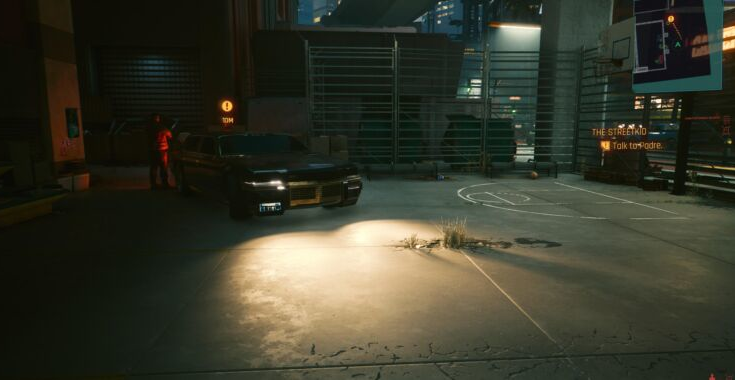Cyberpunk 2077, patch 1.5, PlayStation 5, ray-tracing mode.
The same moment in Cyberpunk 2077, patch 1.5, PlayStation 5, performance mode. Notice how all of the elements now appear to float in 3D space, particularly that basketball (which players can kick around).
CD Projekt RedCyberpunk 2077, patch 1.5, PlayStation 5, ray-tracing mode. The grass actually casts a shadow.
The same moment in Cyberpunk 2077, patch 1.5, PlayStation 5, performance mode. Otherwise, much of the image is identical, and this comparison could lead you to the conclusion that the 30 fps drop for ray tracing isn’t worth it.
CD Projekt Red
While video game consoles have finally reached the age of ray tracing, performing those graphical calculations in real time can still be tough on consumer-level hardware. A PS5 game like Gran Turismo 7, for instance, can only handle ray-traced visuals in replays thanks to the processing requirements.
With a newly filed patent, though, Sony engineer Mark Cerny lays out a method that could significantly speed up the ray-tracing process by offloading certain calculations from the GPU to specially designed ray-tracing unit (RTU) hardware. The outlines of the new ray-tracing process are laid out in a patent application titled “System and method for accelerated ray tracing with asynchronous operation and ray transformation.” The application was published in the European Union last week after being filed last August.
In Cerny’s method, the RTU hardware is specially designed to efficiently traverse so-called acceleration structures in a 3D environment, going through a stack of bounding volumes to identify points where a virtual light ray intersects with an object. Those intersections are then sent to a shader program running on the GPU, which determines whether the object is opaque (a “hit” for the ray-tracing algorithm) or transparent (i.e., the intersection can be ignored).
In the case of a hit, the GPU can then send that information back to the RTU, which can “shorten the ray, as there is no point testing past the location of the intersection of the ray with [the opaque object].” That saves processing time that would be wasted calculating further “hits” for objects that are occluded by a closer object.
Crucially, these RTU functions “can be asynchronous with respect to the shader program.” That means the GPU can perform other functions as it waits for the RTU to send back any intersections it finds between light rays and in-game objects.
Handling these basics functions in the RTU (which “may include hardware circuitry” specially designed for this traversal) “may result in a significant improvement of ray tracing speed,” the patent says, “as the shader program is only performing hit testing. It is not performing acceleration structure traversal or managing the corresponding stack.”
When will we see results?
The publication of a patent like this from Sony suggests the company has its eye on improving ray-tracing performance on the PlayStation 5. But it’s unclear how the method described in this patent would integrate with the console’s current ray-tracing pipeline, which is built on AMD’s RDNA2 architecture.
Rift Apart offers three graphics options. This one is “Performance RT,” which includes real-time ray tracing and a 60 fps frame rate but drops resolution and other detail settings.
This mode is “Quality,” which drops the frame rate to a locked 30 fps (or 40 fps on newer TVs), adds more visual touches, and gets the resolution closer to 4K. While hard to see in screenshot form, this mode does preserve more distant visual details in motion, and its RT system picks up more rays.
SonyThis is “Performance,” which removes ray tracing but stays at 60 fps. Thus far, we don’t recommend bothering with it, as “Performance RT” does a fine job staying near 60 fps while offering more convincing reflections (of which there are a lot in the game).
Sony
That AMD pipeline already uses ray accelerators to help calculate intersections. The pipeline, however, leaves the costly acceleration structure traversal (i.e., moving through a series of “bounding volumes” in 3D space) to the GPU shader. That’s in contrast to Nvidia’s graphics cards, which essentially handle the entire ray-tracing pipeline on specialized cores.
As such, the PS5’s ray-tracing cores may not be designed to efficiently handle the traversal as described in this patent. But future redesigns of the PS5 processor (a la the PS4 Pro) or future Sony hardware altogether could make use of a new hardware architecture designed to take advantage of this patent-pending method.
Or maybe not. Companies often file patents for features that never become consumer products for one reason or another. In this case, the method is buried so deep in the hardware that average users might not even notice if/when it’s implemented. Still, a glimpse at how a company like Sony is looking to improve the efficiency of its graphical pipeline is interesting.
Andrew Cunningham contributed to this report.
Listing image by CD Projekt Red



